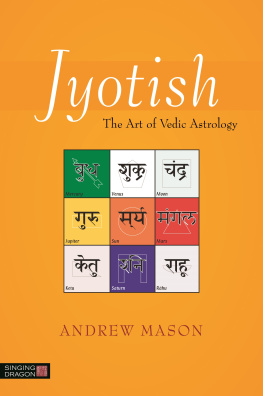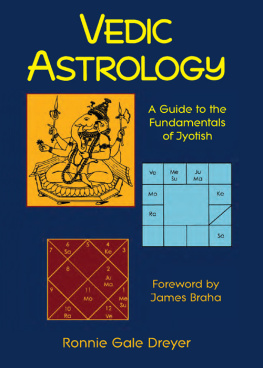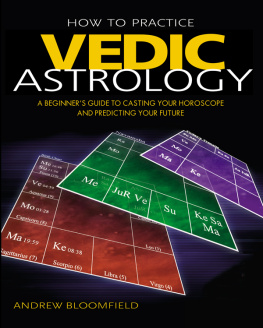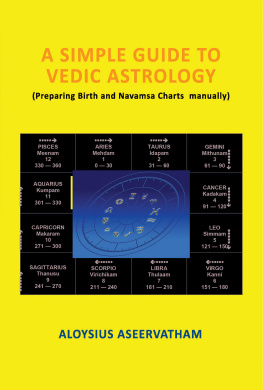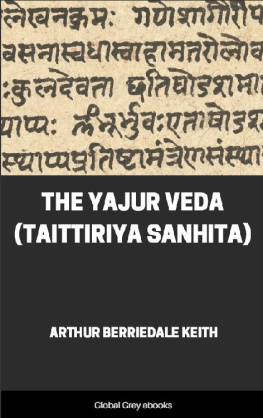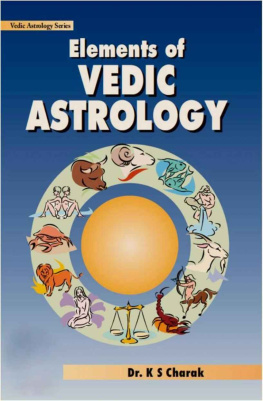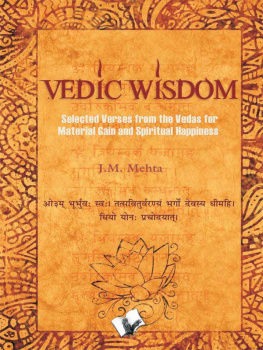deva-gh vai nakatri
The nakatra are the homes of the gods!
Taittirya Brhmaa 1.5.2.8.4
Preface
The idea for this book formed at the end of 2017, at a Vedic Astrology conference in Arizona, when I asked Ernst Wilhelm, Whats new?
He told me that he and his wife were working on a translation of nakatra stra from Taittirya Brhmaa.
I was floored!
I had been trying to study the nakatras for eight years, the entire time consistently dismayed by the lack of a clear, universally accepted, sensible approach to them. It seemed that every third person had some other theory about how we should define their symbolism.
I set out to understand the nakatras as deeply and clearly as possible using only what the Vedas gave (the name and the god), trying make sense of the many prevailing theories through this. The result was my first book on Nakatras: 27 Stars, 27 Gods .
It was a satisfying effort, but I hungered for something more concrete and authoritative. So, when Ernst mentioned that Taittirya Brhmaa had something about the nakatra, I felt like a man dying of thirst in the desert who suddenly finds out that an oasis is nearby!
Ernst directed me to pdfs of the original Sanskrit and I immediately began devouring it, heart, mind, and soul.
It turned out that David Frawley had already written a translation about 20 years ago, but no one had ever brought it to my attention. After an initial look at the original language, I could see why Dr. Frawleys translation didnt catch on and become influential: although a great work, it didnt include the original language, wasnt explained thoroughly enough, mixed Dr. Frawleys ideas, a medieval commentators, and the original text together, without clearly giving the reader a heads up as to which was which, and finally it didnt really catch the essence of two key words found in every sutra.
Ernsts translation was much better, but I thought it also often suffered from not really expressing the essence of the words, especially those two key words (parastt & avastt ). It also did not have clear explanations of the individual stras. I offered to help him edit and finish it, but he and his wife had already been working on it for a long time, were nearly done, and wanted to publish right away. They encouraged me to publish my own translation and commentary, which I immediately set out to do.
One of the attendees at the conference, Lakshmi Mukundan, had grown up studying Sanskrit - so I eagerly availed of her knowledge to confirm all the basic grammars employed in all the stras. Thus, I gradually sketched out the first rough translations and commentaries for all 27 stras.
To confirm the technical accuracy of the translations and edit the Sanskrit overall, I turned to the gracious help of Yulia Mamaeva. Finally, to try and catch most of my copious English typos and grammatical oddities, I sought the generous help of Mathishka Anenden. I, and this work, are greatly indebted to the kindness of all three of them.
This book contains a bit more than Nakatra Stra. In my commentary, and in an appendix, I include other sections from the same Taittirya Brhmaa that also talk about the nakatras: a complete set of fascinating supplications to each nakatra, and a description of the relevance of many nakatras in electional astrology. I also supplement the book with a section entitled, The True Story of the Nakatra Gods : a dramatic narration of the 27 nakatra divinities, focused on what is most relevant to their nakatras symbolism. This original work pulls together diverse Puric and Vedic source material to paint a vivid picture of often unknown tales and details essential for fully understanding the subtleties of the 27 Vedic stars.
Introduction to
Nakatra Stra
The Nakatra Stra is a treasure found in the Taittirya Brhmaa, a branch of the ancient Yajur Veda. Because of this, it holds unique importance and unparalleled authority among nakatra texts, for it allows us to understand the nakatras in much clearer accord with the Vedic sages who originally envisioned them.
For each stra, I give the original Sanskrit (in Devanagari and in roman diacritics), an English translation, a word-by-word breakdown, and a commentary that also explains the stras interpretive ramifications for natal astrology, and the important wisdom it provides us about life. I also include a translation of Taittiryas supplication to each nakatra.
I give a brief depiction of various planets in each nakatra. Use this as a baseline and starting point for interpreting nakatras effectively, modify the baseline using standard principles of chart analysis. Consider not just the fundamental nature of the planet (as is done here in the text itself), but also the incidental nature it carries due to the houses it owns and occupies, etc.
Each stra has four short parts.
The first part names the god or goddess who owns the nakatra . It assumes the reader is intimately familiar with these divinities. This, of course, is almost never the case in modern times, so I explain the most relevant points in the commentary and supplement the entire text by including The True Story of the Nakatra Gods.
The second part names the nakatra . This name almost always denotes an action, undertaken by or for the nakatras god or goddess.
The third part describes what the nakatras action requires . This reveals what the nakatra is dependent upon to function successfully, and thus identifies the nakatras weak point or dependency.
The fourth part describes the goal of the nakatras action, revealing the nakatras ultimate motive and effect.
In each and every stra the third part is indicated by the word parastt, the fourth part by avastt. The simplicity and elusive connotation of these two words is the biggest initial barrier to understanding the stras effectively.
In the simplest literal terms, parastt means above and avastt means below. Understanding the implications of para and ava, however, is crucial to really get the way these two words are used in the stras here.
Para means above in the sense of a supportive superior, like that of a parent . Every nakatra has a parastt; a thing that supports it, shelters it; a thing it needs to subduct from above if it hopes to achieve the goal of its action. Thus the parastt really indicates what the nakatra needs.
Ava means downward in the sense of something that comes down; an end-product; a result. Every nakatra has an avastt; the thing it wants to produce; like an egg falling out and down from a bird - the avastt identifies the thing you will get if you stand below a nakatra with your arms open.
One final introductory note:
Stras, by design, compact volumes of meaning and information into a very few, carefully chosen and well crafted words. Tittiri, the author of Taitirya Brhmaa and its nakatra stra, has distilled volumes of information about each nakatra into just six or occasionally seven words! Patient, careful, and deep contemplation is needed to fully unlock the wonderful wisdom and extremely useful astrological symbolism woven within them.
:
hari au
pacama praphaka prrambha
Hari Au.
The fifth chapter begins.
hari au :
sacred invocation of Hari
pacama :
fifth
praphaka :
chapter
prrambha :
begins
This auspicious invocation begins the fifth chapter of the first division of Taitirya Brmaa, part one of which is the nakatra stra.
Kttik
The Catalyst
agne kttik
ukra parastj jyotir avastt
Fires catalysm
needs fuel for light.
agne :
of Agni
(fire, the catalyst)
kttik :
the activator, doer, catalyser
ukram :
fuel




